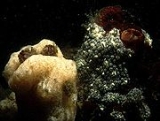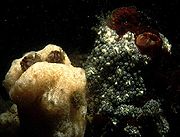
Botryllus schlosseri
Encyclopedia
Botryllus schlosseri, commonly known as the star ascidian or golden star tunicate, is an invasive
, colonial
ascidian
tunicate
that grows on slow-moving, submerged objects, plants, and animals in nearshore saltwater environments.
Individual zooids may grow to 3 millimetre (0.118110236220472 in) in size, with colonies reaching 50 millimetres (2 in) long .
 Its range has spread over the last 100 years to a nearly worldwide extent. Ranging in the western Atlantic Ocean
Its range has spread over the last 100 years to a nearly worldwide extent. Ranging in the western Atlantic Ocean
from the Bay of Fundy
to North Carolina
, this is "the most common colonial tunicate in North America."
This species can be distinguished from Botrylloides
sp. by the pattern of zooid growth. B. schlosseri zooids emanate from a center in the manner of the arms of a star. Also, there usually are fewer zooids per cluster (5–8 in B. schlosseri and 10 or more in Botrylloides). There are many colors in which this species can be found, ranging from orange, blue and grey. A colony can be easily be separated from the main body to form an independent colony usually referred to as a subclone. Two colonies may also fuse together if they share a common allele for fusibility histocompactibility.
When sexually productive, these Botryllus are known to produce,"yellowish-white or pale orange tadpole larva" exhibiting an oval outline.
In a study conducted by Heather Boyd, from Stanford University, it was concluded by comparing morphological and genetic experiments that "Botryllus from the Monterey and from Woods Hole, Massachusetts, may be designated contingently as Botryllus schlosseri."
Invasive species
"Invasive species", or invasive exotics, is a nomenclature term and categorization phrase used for flora and fauna, and for specific restoration-preservation processes in native habitats, with several definitions....
, colonial
Colony (biology)
In biology, a colony reference to several individual organisms of the same species living closely together, usually for mutual benefit, such as stronger defense or the ability to attack bigger prey. Some insects live only in colonies...
ascidian
Ascidiacea
Ascidiacea is a class in the Tunicata subphylum of sac-like marine invertebrate filter feeders. Ascidians are characterized by a tough outer "tunic" made of the polysaccharide tunicin, as compared to other tunicates which are less rigid.Ascidians are found all over the world, usually in shallow...
tunicate
Tunicate
Tunicates, also known as urochordates, are members of the subphylum Tunicata, previously known as Urochordata, a group of underwater saclike filter feeders with incurrent and excurrent siphons that is classified within the phylum Chordata. While most tunicates live on the ocean floor, others such...
that grows on slow-moving, submerged objects, plants, and animals in nearshore saltwater environments.
Individual zooids may grow to 3 millimetre (0.118110236220472 in) in size, with colonies reaching 50 millimetres (2 in) long .

Atlantic Ocean
The Atlantic Ocean is the second-largest of the world's oceanic divisions. With a total area of about , it covers approximately 20% of the Earth's surface and about 26% of its water surface area...
from the Bay of Fundy
Bay of Fundy
The Bay of Fundy is a bay on the Atlantic coast of North America, on the northeast end of the Gulf of Maine between the Canadian provinces of New Brunswick and Nova Scotia, with a small portion touching the U.S. state of Maine...
to North Carolina
North Carolina
North Carolina is a state located in the southeastern United States. The state borders South Carolina and Georgia to the south, Tennessee to the west and Virginia to the north. North Carolina contains 100 counties. Its capital is Raleigh, and its largest city is Charlotte...
, this is "the most common colonial tunicate in North America."
This species can be distinguished from Botrylloides
Botrylloides
The "Chain Sea Squirts or Chain Tunicates" of the genus Botrylloides:Morphologically similar to Botryllus schlosseri and similarly widespread, Botrylloides is distinguished by having linearly-arranged, parallel "chains" of zooids as opposed to zooids like white or yellow stripes emanating from a...
sp. by the pattern of zooid growth. B. schlosseri zooids emanate from a center in the manner of the arms of a star. Also, there usually are fewer zooids per cluster (5–8 in B. schlosseri and 10 or more in Botrylloides). There are many colors in which this species can be found, ranging from orange, blue and grey. A colony can be easily be separated from the main body to form an independent colony usually referred to as a subclone. Two colonies may also fuse together if they share a common allele for fusibility histocompactibility.
When sexually productive, these Botryllus are known to produce,"yellowish-white or pale orange tadpole larva" exhibiting an oval outline.
In a study conducted by Heather Boyd, from Stanford University, it was concluded by comparing morphological and genetic experiments that "Botryllus from the Monterey and from Woods Hole, Massachusetts, may be designated contingently as Botryllus schlosseri."

